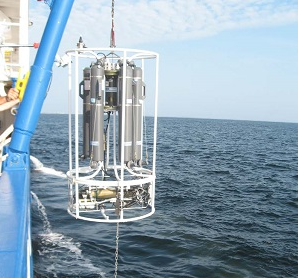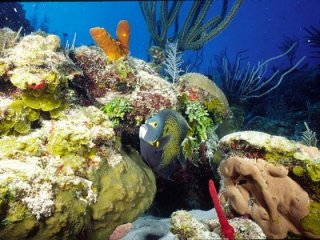MPRSA Ocean Site Monitoring and Management
The EPA is responsible for monitoring and managing all designated MPRSA ocean sites (33 USC 1412). Ocean sites are required to have a site management and monitoring plan (SMMP) which include strategies for management and monitoring of the site. Managing MPRSA ocean sites involves regulating the times, quantity and characteristics of material released at the site, and establishing release controls, conditions and requirements to avoid or minimize potential impacts to the marine environment. During and after MPRSA permitted activities are conducted, management of ocean sites is informed by information collected during oceanographic monitoring of the MPRSA ocean site and the surrounding area. Monitoring ocean sites and the surrounding areas helps the EPA to verify that unanticipated adverse effects are not occurring from past or continued use of the site and to ensure MPRSA permit conditions are met.
On this page:
MPRSA Ocean Site Monitoring
The EPA's Regional MPRSA Coordinators and Chief Scientists conduct oceanographic surveys to monitor the impacts of regulated activities at MPRSA ocean sites. The EPA typically evaluated environmental impact at a site by comparing present day conditions to those at the time of designation (baseline conditions) along with any other historical survey data. Under the MPRSA (section 102(c)) and its implementing regulations (40 CFR 228), the EPA uses oceanographic monitoring data to evaluate potential ocean sites and designate ocean sites for future use, and evaluate impacts after use. Based on the monitoring results, the EPA may modify site use, prohibit dumping where necessary and update the SMMP for the site.
The EPA's Regional MPRSA Coordinators and Chief Scientists often conduct site monitoring activities at MPRSA dredged material ocean sites in coordination with the U.S. Army Corps of Engineers (USACE). Individual projects using MPRSA ocean sites are also monitored for compliance with the EPA's site use conditions.
The EPA's Regional MPRSA Coordinators and Chief Scientists plan and conduct oceanographic surveys at and around ocean sites located off the U.S. Atlantic, Gulf and Pacific Coasts, and in the Caribbean, Hawaii and the Pacific Islands.
Learn more about EPA Chief Scientists.
Types of Data Collected During Ocean Monitoring Surveys

Water Quality
The EPA may use water quality data to detect any changes in water quality within an ocean site or outside the boundaries as a result of activities permitted under the MPRSA. These data may be obtained by collecting water samples from various depths and analyzing the samples for chemical and other parameters, such as water clarity (turbidity), oxygen concentration or pH. Special sensors may be used to collect data for some water quality parameters directly from ocean waters.
Sediment
The EPA may use sediment data to determine if any changes in the quality or composition of sediment in an ocean site or outside the boundaries of the site are due to activities permitted under the MPRSA. Sediment samples may be collected for chemical, grain size or other analyses such as organic carbon content. Special cameras may be lowered from survey vessels to the seafloor to collect information about the composition of the sediment.

Living Resources
The EPA may use biological data to determine if changes to living resources within an ocean site or outside the site’s boundaries are due to activities permitted by the MPRSA. Living resources may include fish as well as animals that live in the sediments such as clams and worms. To detect changes (impacts) to living resources, the EPA may evaluate contaminant levels in the tissues of animals that live in and around the ocean site or may assess changes in biological community, including the relative abundance of individual species.
Water Currents
The EPA uses water current data to better understand the fate and transport of material that are permitted under the MPRSA (e.g., how material disperses or drifts after it is released in ocean waters).
Bottom Topography (Bathymetry)
In the same way that topographic maps represent three-dimensional features of overland terrain, bathymetric maps illustrate the land that lies underwater. The EPA uses bathymetry (bottom topography) data to map the seafloor within an ocean site and in the surrounding area and to help document where the material deposits after it is released in the ocean. Some material may deposit in low spots on the seafloor within an ocean site. If the material piles up and mounds form, the water depth in the ocean site may become too shallow for safe navigation. Ensuring that activities permitted under the MPRSA do not impact navigation is an important aspect of the EPA’s management of ocean sites. To direct and prioritize sampling activities, the EPA may use bathymetric data to identify areas where materials permitted under the MPRSA are present on the ocean floor.
Individual Project Compliance Monitoring
Compliance monitoring is intended to ensure that the conditions of the Marine Protection, Research and Sanctuaries Act (MPRSA) permit (or, in the case of federal projects, authorization) are met and that the material is released at the correct location.
The EPA, USACE, other federal agencies, and MPRSA permittees often conduct compliance monitoring activities. For example, MPRSA permittees may be required to provide detailed records of GPS tracking of the transit of the vessel(s) carrying the material to the ocean site. Other measurements, such as how deep the vessel sits in the water (draft of the vessel) transporting the material to the ocean site, may be required to document whether the material has leaked or spilled from the vessel to the site and to confirm that the material is released in the site in accordance with site use and permit conditions.
The instrumentation for compliance monitoring typically is comprised of a proprietary bundle of software and off-the-shelf hardware components (GPS receiver, draft sensors, data logger and data transmitter).
MPRSA Ocean Site Management
The EPA typically evaluates environmental impact at an MPRSA ocean site by comparing current conditions to those at the time of designation (baseline conditions) along with any other survey data. These data comparisons can inform the EPA’s MPRSA Coordinator on whether and how to modify management of the site and site use. Modifying the site and site use allows the EPA to adaptively manage the MPRSA ocean site to maximize its capacity and minimize the potential for any long-term adverse effects to human health, the marine environment, and other uses of the ocean.
Modifications to the site and site use can include changing the ocean site boundaries (e.g., expanding or decreasing the size of the site), cancelling (de-designating) the site, regulating the times, quantity and characteristics of material released at the site; and establishing release controls, conditions and requirements to avoid or minimize potential impacts to the marine environment, among other modifications.
MPRSA ocean site modifications are completed through rulemaking and are published at 40 CFR 228.15.
Site Management and Monitoring Plans
All designated MPRSA ocean sites are required to have a site management and monitoring plan (SMMP). SMMPs include management and monitoring requirements to ensure that materials released at ocean sites are suitable for permitting and that adverse impacts of MPRSA permitted activities are avoided.
For designated dredged material sites, the EPA, together with USACE, is responsible for developing and providing an opportunity for public comment on the SMMP. SMMPs must be reviewed and appropriately revised at least every 10 years.
Each SMMP includes the following, but may not be limited to:
- a baseline assessment of site conditions;
- a program for monitoring the site;
- special management conditions or practices to be implemented at each site that are necessary for protection of the environment;
- consideration of the quantity of disposed materials, and the presence, nature and bioavailability of the contaminants in the material;
- consideration of the anticipated long-term use of the site; and
- a schedule for review and revision of the SMMP.
SMMPs for each designated MPRSA ocean site can be found on the EPA's Regional Guidance webpage.
MPRSA Ocean Site Monitoring Results
The EPA develops an annual National Marine Protection, Research and Sanctuaries Act Ocean Site Monitoring Assessment Report that serves as a comprehensive summary of the EPA's oceanographic monitoring activities in a given year. Specifically, the report summarizes survey objectives and activities completed, scientific results collected, and site management decisions informed by oceanographic monitoring conducted by the EPA's MPRSA Coordinators and Chief Scientists.
National Ocean Site Monitoring Reports are available on the National MPRSA Ocean Site Monitoring Report webpage.
